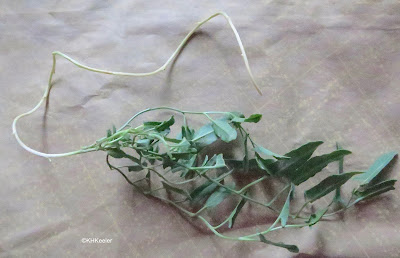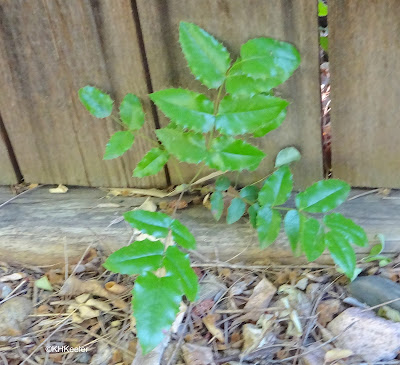I like plants. I have a yard and garden. This week, weeding, I contemplated weeds. What exactly are they?
"Weed" is a wonderful concept. It is totally human; a weed is a plant that interferes with human activity, which can be reduced to "a plant in the wrong place." I checked the American Weed Science Society's website--they dedicate their careers to controlling weeds, so need a good working definition--and that website defines a weed as "a plant that causes economic losses or ecological damage, creates health problems for humans or animals, or is undesirable where it is growing."
Not everyone uses the word weed the same way, however. An article on weeds in my local weekly, by a Colorado State Extension agent, said, "No native plants can be considered a weed even though we may think they are."(Bokan, 2021). When I was working on weed biology in the 1980s, we quoted a member of the Nature Conservancy in England who said, "If it grows in England, I don't consider it a weed" (source lost). Those are valid viewpoints, but I don't use those definitions for weed. I can love natives and still call them weeds. However, varying definitions mean you should find out what the other person calls a weed before going very far in an argument over weeds.
The definition that the Weed Science Society and I use covers lots of different plants, because human activities are diverse. Weeds vary with area and land use. The weeds of annual crops, such as wheat, are different plants from the weeds of walnut tree plantations; many of the weeds of suburban lawns do not occur much of anywhere else; and aquatic weeds are another group entirely. Any plant can be a weed if we don't want it.
The weeds known to millions of gardeners are generally fast-growing plants which are not particular about how much sun, or water, or nutrients they get, and that will produce at least a few seeds under poor conditions, but thousands of seeds in a good site. Annuals make good weeds because they grow fast; annuals die with the coming of winter so they produce as many seeds as possible before that. Lambsquarters (Cheopodium album), wild lettuce (Lactuca spp.) and purslane (Portulaca oleracea) are examples.
 |
| Wild lettuce (Lactuca sp.) and lambsquarters (Chenopodium album) at the edge of my vegetable garden |
Many lawn weeds are perennials that are hard to remove. Dandelions (Taraxacum officinale) persist because it is hard to dig out all of their deep tap roots; field bindweeds (Convolvulus arvensis) sprout from long underground rhizomes (rhizomes are underground stems); the tubers (similar to bulbs) of yellow nutsedge (Cyperus esculentus) break off in the soil if you try to pull up the plants.
 |
| field bindweed (Convolvulus arvensis) and a piece of rhizome The rhizomes can be much longer. |
Some plants are classed as weeds because they are toxic to livestock (locoweeds Astragalus and death camas Zygadanus/Toxicoscordion) or spiny (thistles Cirsium and Carduus, and puncture vine, Tribulus terrestris).
What felt weird about all that was realizing that in my yard, I define weed. Of course, my neighbors and the county would step in if I embraced noxious weeds like yellow star thistle (Centaurea solstitialis) and purple loosestrife (Lythrum salicaria). But the noxious weed lists include only a couple dozen plants out of thousands available to me.
But beyond those few legally defined weeds, a weed is anything I don't want. Therefore the snow-in-summer (Cerastium tomentosum) invading the creeping juniper, the speedwells (Veronica) over the edge of their bed, and the larkspurs (Delphinium) in the flagstone path are all weeds. In cases like these, I have a place where the plant is not a weed, where I am happy to have it, so if asked, I probably wouldn't call snow-in-summer or the speedwell weeds.
 |
| The speedwell (Veronica) with the blue flowers is a plant I want in the lower flower bed, and a weed (unwanted plant) above the stone border. |
But there are plants in my garden that reproduce so well that although they started out being welcomed, now I consider them weeds most of the time. That would include creeping hollygrape (Berberis repens) which has seeded in all across my yard, and a variegated periwinkle (Vinca) that I tried to move but has come up in the original spot for more than a decade, despite me.
 |
| yet another creeping grapeholly Berberis repens where I don't want it |
Comments and corrections welcome.
References
Bokan, S. 2021. What makes weeds so successful? Loveland Weekly. Sept. 15-21. p. 5.
Glossary. Weed Science Society of America. https://wssa.net/wssa/wssa-glossary/#C23 Accessed 9/16/21.
More at awanderingbotanist.com

Hi there
ReplyDeleteRecipe for delicious and healthy dandelion salad, from Greece:
Before the dandelion produces buds and flowers, cut the whole plant, along with a small piece of root, by placing the knife below the soil surface. Wash them very well.
Boil them until soft. Boil potatoes together, with or without the skin (you can remove the skin later).
Drain well and serve the salad with salt, olive oil and lemon or vinegar. It goes great with fried fish.
Good appetite
Leonidas
Athens, Greece
Thank you!
ReplyDeleteI just found your blog! It's such a wonderful resource! Thank you for sharing!
ReplyDeleteA lot of innovation is happening today among Plastic Weed Barrier Manufacturers, particularly in developing eco-friendly yet durable sheets that help prevent unwanted plant growth. While comparing suppliers, I noticed the Plastic Weed Barrier Manufacturers who supply woven mats with high tensile strength and long life, making them ideal for commercial farms and greenhouses.
ReplyDelete